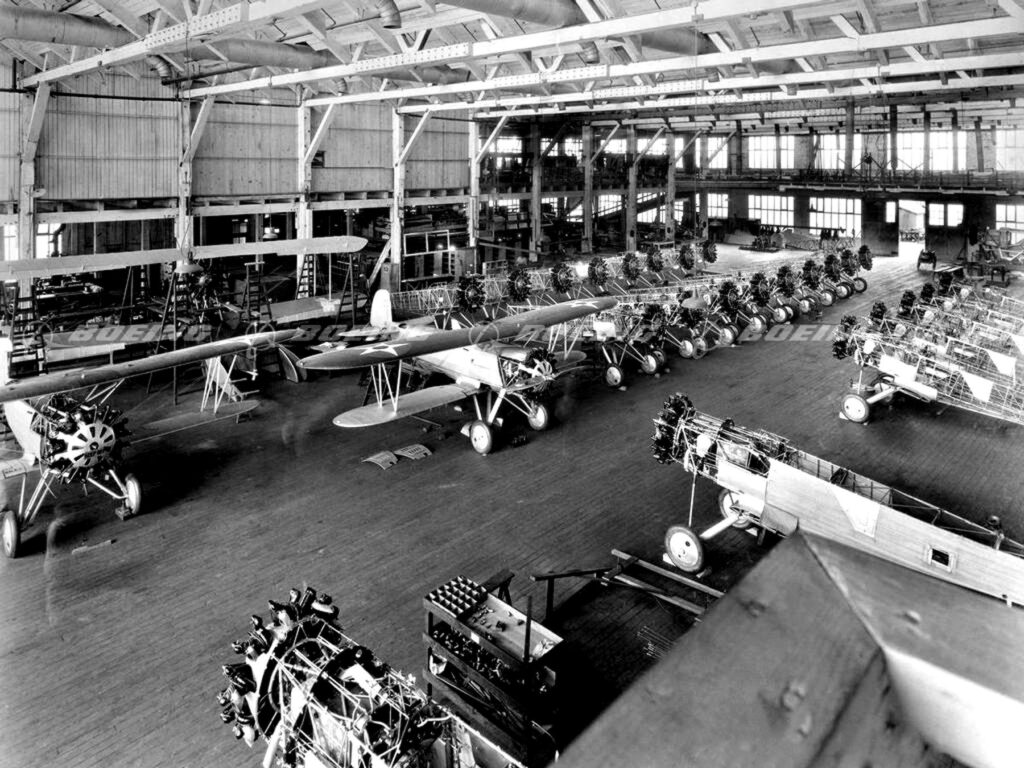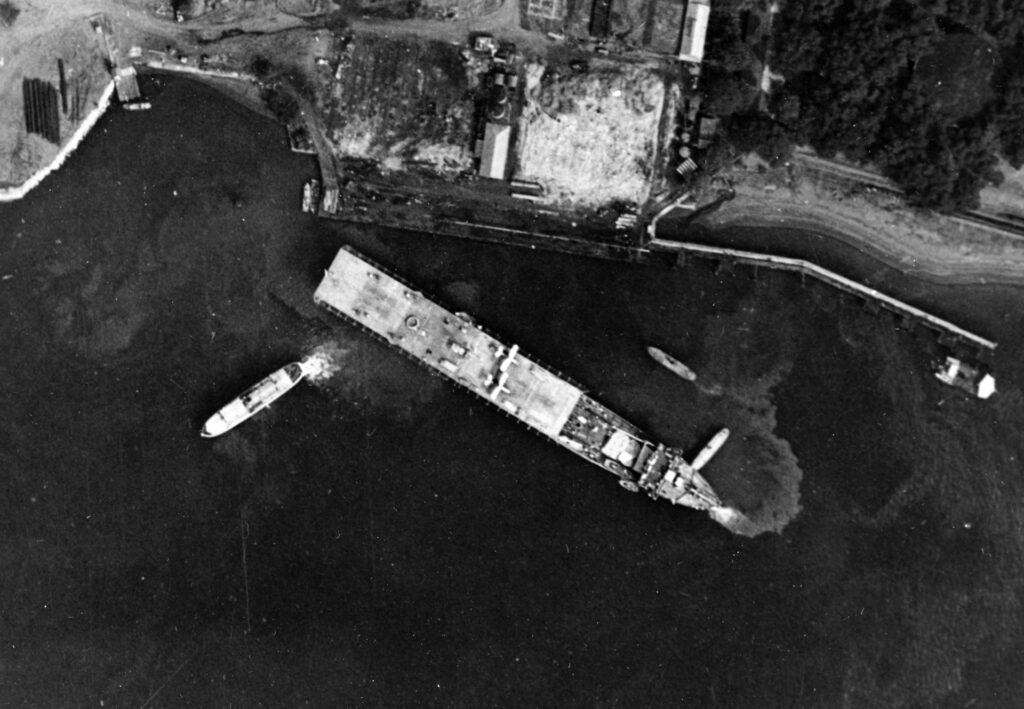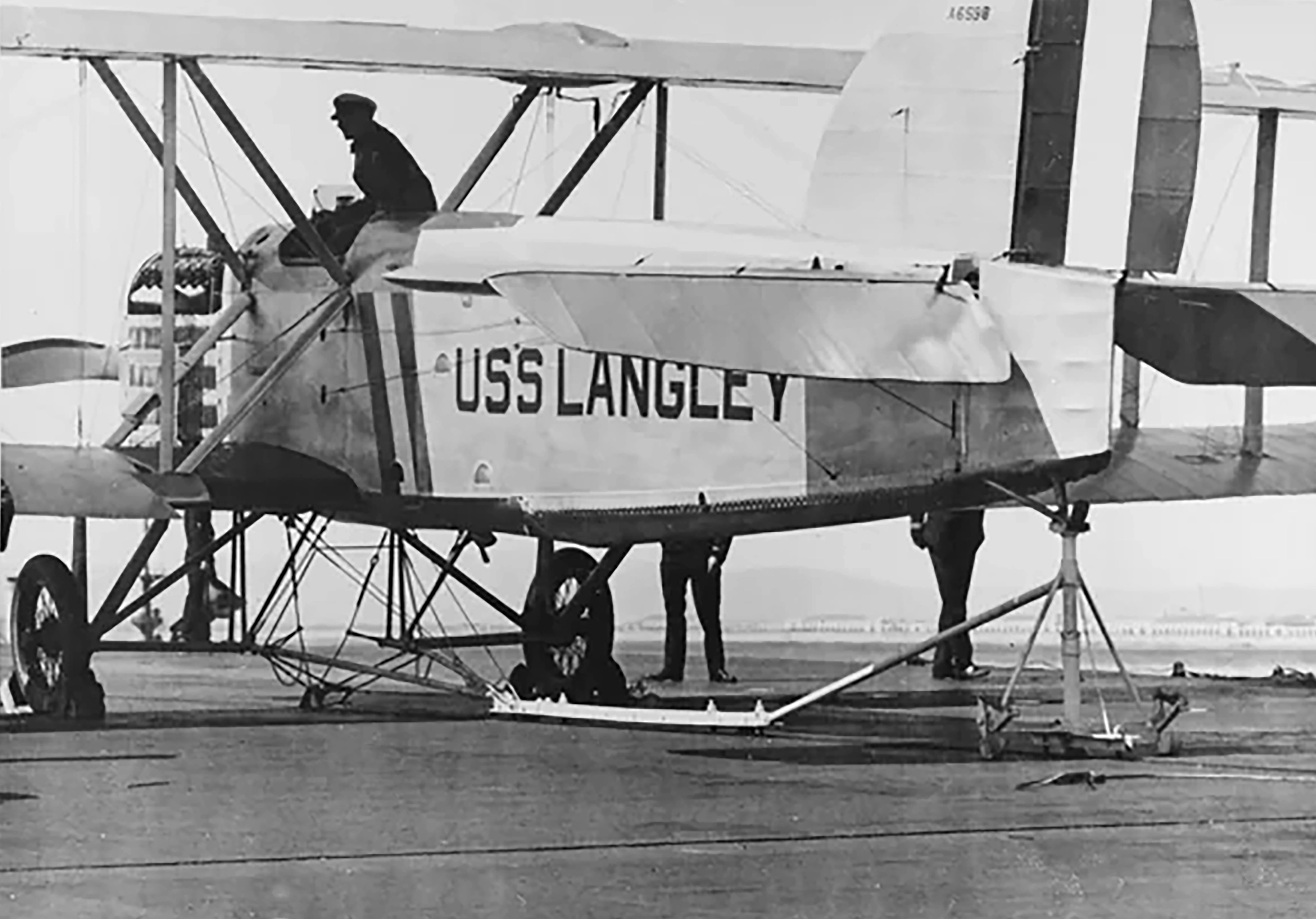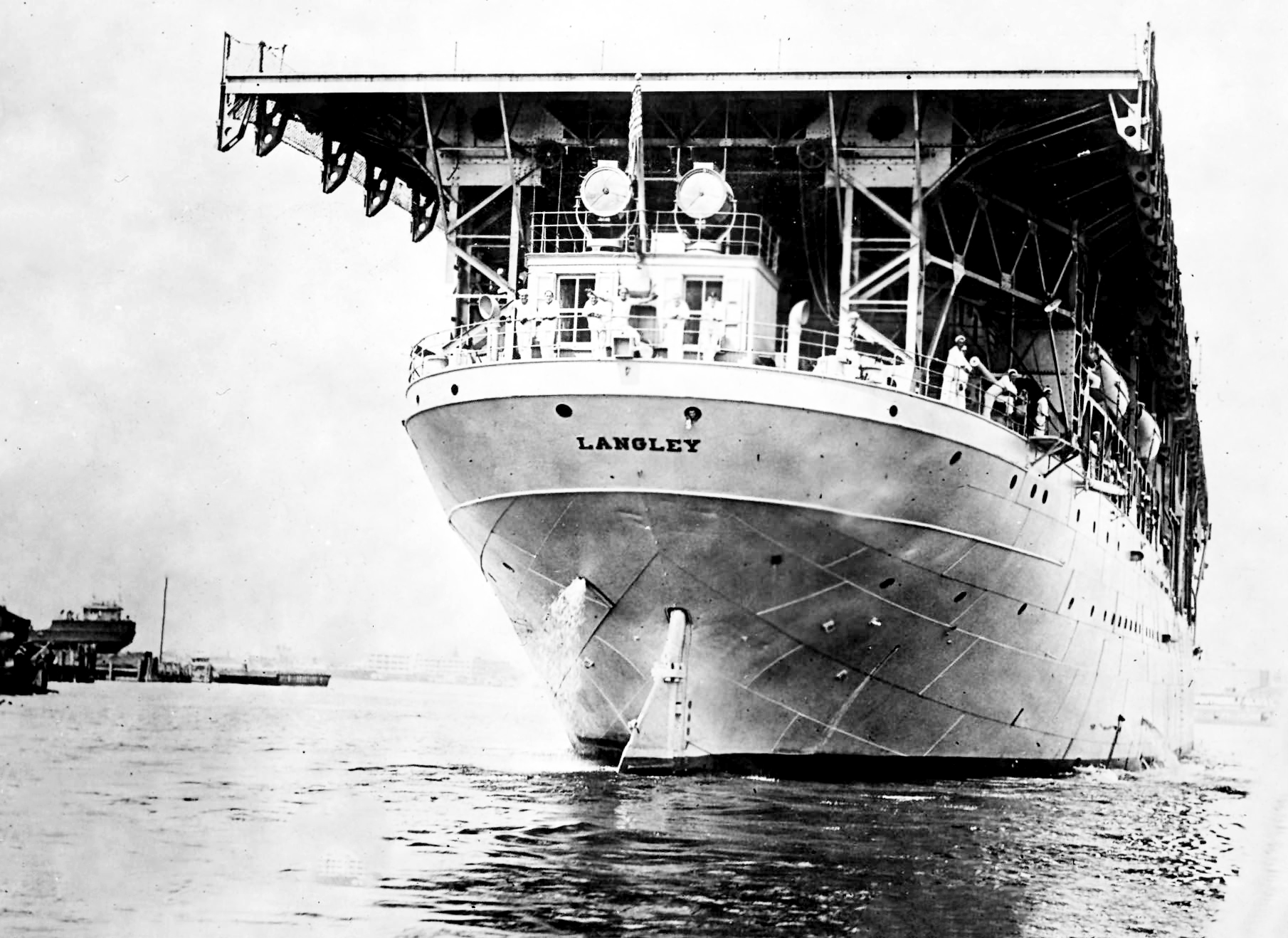“Obviously, I was challenged by becoming a Naval aviator,
by landing aboard aircraft carriers and so on.”
Alan Shepard (1923-98), USN 1944-74, RADM (ret)
The USS Langley (CV-1), as the first carrier vessel in the U.S. Navy, was pivotal in the history of naval aviation warfare. It served as a test bed for developing procedures and technologies still used on aircraft carriers today. It was originally nicknamed “Covered Wagon” by its crew due to its appearance. Following World War I, the growing importance of aviation in naval warfare led to authorization to convert the USS Jupiter (AC-3), a collier (coal tender), into an aircraft carrier on 11 Jul 1919. The conversion was carried out at the Norfolk Navy Yard, involving the addition of a flight deck and aircraft elevators. The large coal holds of the collier proved suitable for conversion into aircraft hangars. The retrofitted ship’s dimensions were 542 ft. length, sixty-six ft. beam, draft of twenty-four ft. with a displacement of more than 15,000 tons; fully loaded, it carried twenty-two to thirty-six aircraft and four .50-cal. deck guns. The carrier could make about 15 knots, and its full complement (including the air arm) was 468. On 11 Apr 1920, the ship was renamed USS Langley (CV-1) in honor of aviation pioneer Samuel Pierpont Langley, an American scientist and inventor, and was recommissioned on March 20, 1922.

USS Langley (CV-1) Conversion
The Langley was possibly the first military surface ship propelled by turbo-electric motors when originally commissioned under her prior designation in April 1913. Following tests in the Atlantic in 1924, she became the test platform for developing carrier operating techniques and tactics while serving in the Pacific. Article VIII of the Washington Naval Treaty provided an exemption for experimental aircraft carriers in existence or building on 12 November 1921. The Washington Naval Treaty was signed on 6 February 1922, and Langley was recommissioned for the purpose of conducting experiments in seaborne aviation.
USS Langley (CV-1) First Flights
The commanding officer was Commander Kenneth Whiting, who had first proposed the conversion of a collier three years earlier. Langley was designed to carry up to thirty-four airplanes (twelve single-seaters, twelve two-seaters, and ten torpedo-dropping aircraft}. As the first American aircraft carrier, Langley was the scene of several seminal events in US naval aviation. On 17 Oct 1922, Lt. Virgil C. Griffin piloted the first plane, a Vought VE, launched from her full-length wooden deck. Though this was not the first time an airplane had taken off from a ship, and though Langley was not the first ship with an installed flight deck, this one launch was of monumental importance to the modern US Navy. With Langley underway nine days later, Lieutenant Commander Godfrey de Courcelles Chevalier made the first landing, in an Aeromarine 39B. On 18 Nov, Commander Whiting was the first aviator to be catapulted from a carrier’s deck.

USS Langley (CV-1) Features
An unusual feature of Langley was provision for a carrier pigeon house on the stern between the 5-inch guns. Pigeons had been carried aboard seaplanes for message transport since World War I, and were to be carried on aircraft operated from Langley. But, the pigeons never went to sea again, and the former pigeon house became the executive officer’s quarters; though early plans for conversion of USS Lexington and Saratoga included compartments for pigeons. In 1927, Langley was at the Guantanamo Bay Naval Base. For the next twelve years, she operated off the California coast and Hawaii, engaged in training fleet units, experimentation, pilot training, and tactical-fleet problems.
World War II Action
Reclassified as a seaplane tender (AV-3), in 1937, Langley remained on station in the Pacific supporting seaplane patrols and aircraft transportation services during the early months of World War II. In the early hours of 27 Feb 1942, Langley rendezvoused with the destroyers USS Whipple and Edsall, which had been sent from Tjilatjap to escort her. Later that morning, a Japanese reconnaissance aircraft located the formation.

USS Langley Attack
At 1140, about seventy-five nautical miles south of Tjilatjap, the seaplane tender, along with her escorts, was attacked by sixteen Mitsubishi G4M “Betty” bombers of the Imperial Japanese Navy service’s Takao Kōkūtai, led by Lieutenant Jiro Adachi, flying out of Denpasar airfield on Bali, escorted by fifteen A6M2 Reisen fighters. Rather than dropping all their bombs at once, the Japanese attacked, releasing partial salvos. Since they were level bombing from medium altitude, Langley was able to alter helm when the bombs were released and evade the first and second bombing passes. But the bombers changed their tactics on the third pass and bracketed all the directions Langley could turn. As a result, she took five hits from a mix of 130 and 550 lb bombs with sixteen crewmen killed. The topside burst into flames, steering was impaired, and the ship developed a list to port. Langley went dead in the water as her engine room flooded. At 1332, the order to abandon ship was passed. After sailing forth for the surviving crew and passengers (Whipple rescued 308 men and Edsall 177) at 1358, the escorting destroyers stood off and began firing nine 4-inch shells and two torpedoes into Langley’s hull at 1429, to prevent her from falling into enemy hands. The Langley was so badly damaged that she was scuttled by her escorting destroyers. Her sister ships were Cyclops, which disappeared without a trace in World War I, Proteus, and Nereus – both of which disappeared on the same route as Cyclops in World War II. Her electric drive, designed by William Le Roy Emmet and built by the General Electric Company, consisted of two electric motors, each directly connected to a propeller shaft, powered by a single Curtis turbine and alternator set. At 2,000 rpm and 2,200 volts the set delivered a speed of fifteen knots with propellers at 110 rpm. There was also a weight saving with the turbo-electric drive being 156 tons versus the 280 tons of equivalent machinery for Cyclops.

USS Langley Legacy
Commander Eugene E. Wilson’s recollection of a discussion with ADM Joseph “Bull” Reeves during the period when the Langley was the U.S. Navy’s sole aircraft carrier, the number of embarked aircraft became a point of contention. Wilson, Reeves’ chief of staff, recalled concerns about the number of planes, stating that “Langley officers had crystallized the opinion that not more than a third as many, say twelve airplanes, could be flown off the Langley and be received back on board without hazard to the lives of the pilots. That key factor of safety had been argued out in conferences but ‘Bull’ Reeves had stood pat.” An individual reflecting on the ship’s anniversary referred to it as the “pioneering ‘First Lady’ of naval aviation and emphasized that “…the Langley’s legacy endures aboard the massive nuclear-powered carriers that now sail with America’s fleet.” Langley’s repeated attempts to launch and land aircraft from ships at sea inspired the Navy, after his death in 1906, to carry on his legacy. The ship’s identity was also eventually designated as (CVL-27) and (AV-3). Navy TWS records forty-two members who had served with her.
Navy Carrier Expansion
The US Navy has attempted a total of 151 aircraft carriers. This includes all classes and types of carriers, from the first, (USS Langley), to current nuclear-powered supercarriers. The Langley has the distinction of training pilots for the carriers Lexington and Saratoga. The Navy rapidly expanded our carrier fleet during WWII, building a large number of Essex-class and other types of carriers. By the end of that war, the Navy had a total of ninety-nine operational. Afterward, they continued to develop and operate carriers, including the early nuclear USS Enterprise (CVN-65) and contemporary variants. The current Navy fleet includes eleven nuclear-powered carriers which are the backbone of our naval power. The United States Navy has deployed a total of eighty-one aircraft carriers throughout its history. That number includes commissioned vessels, decommissioned ships, those under construction, and those never completed. The peak number of carriers was about 105 at the end of World War II, many of which were escort carriers. Currently, the Navy has eleven carriers in active service, making it the country with the largest carrier fleet in the world. These include both Nimitz-class and the newer Gerald R. Ford-class supercarriers. The US Navy also operates nine amphibious assault ships that can function as smaller aircraft carriers. As of July 2025, there are an estimated fifty active aircraft carriers worldwide, operated by fifteen navies. The United States Navy possesses the largest fleet of this class, followed by China and Japan. We have the largest deck space and fleet number.

USS Langley Honors
USS Langley (as AV-3) earned two battle stars on its Asiatic-Pacific Campaign Streamer: one for the Philippine Islands Operation, 8 Dec 1941-6 May 1942; and one for the Netherlands East Indies Engagements, 23 Jan-27 Feb 1942. In addition, as Jupiter, she earned the Mexican Service and WWI Victory medals. Langley is honored through various memorials and dedications. A notable one (see photo below) is the Aircraft Carrier Memorial in San Diego, featuring a black granite obelisk engraved with the names of all U.S. Navy aircraft carriers, including the USS Langley. Additionally, Memorial Park in DeBary, Florida, prominently displays the USS Langley’s anchor, alongside an F-15 Eagle aircraft. The National Air and Space Museum also frequently features the Langley in exhibits and commemorations of naval aviation history. The National Naval Aviation Museum in Pensacola, FL, has hosted events focused on the history of the Langley and its role in naval aviation. The U.S. Naval Institute and Navy.mil feature the USS Langley in their historical accounts and collections. The Australian War Memorial also holds records related to the Langley. She was featured in the 1929 silent film about naval aviation, “The Flying Fleet.” Apart from size (USS Gerald R. Ford CVN-78 is nearly twice the length), lethality (the Ford carries seventy-five aircraft), complement (Ford has 4,550 personnel), and vast technological advancements, modern carrier basic design has not changed much. This great ship now lies over three miles below in the Pacific, a memorial to her crews and the visionaries who imagined any of it was even possible a century ago.
Read About Other Famous Military Units
If you enjoyed learning about USS Langley (CV-1) By A3C Michael Bell, we invite you to read about other Famous Units on our blog. You will also find military book reviews, veterans’ service reflections and more on the TogetherWeServed.com blog. If you are a veteran, find your military buddies, view historic boot camp photos, build a printable military service plaque, and more on TogetherWeServed.com today.

0 Comments